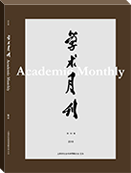-
[1]
Tie LYU
, Zaichi LI
. Digital Transformation in Manufacturing SMEs. Academic Monthly,
2022, 54(10): 59-69.
-
[2]
,
,
. . Academic Monthly,
2016, 48(03): 37-47.
-
[3]
Zhiyang LIU
, Lufeng WANG
. The Emergence Logic of Social Enterprise in China. Academic Monthly,
2019, 51(10): 82-91.
-
[4]
Keyun ZHANG
, Min LIU
. Media Concern and Corporate Social Responsibility Performance. Academic Monthly,
2021, 53(9): 57-71.
-
[5]
Huihua NIE
, Guangwu LI
, Chen LI
. The Eight Key Questions about Subsidies for Enterprises. Academic Monthly,
2022, 54(6): 47-60.
-
[6]
Zhiyang LIU
, Yongchang CHEN
. Social Enterprise’ Hybrid Logic and Cross-sectoral Collaboration. Academic Monthly,
2021, 53(11): 85-98.
-
[7]
,
. Industrial Policy, Firm Exit and Regional Production Efficiency Dynamics in China. Academic Monthly,
2018, 50(04): 33-45.
-
[8]
Changyuan LUO
, Ziqi LIU
. The Impact of Economic Slowdown on Entrepreneurship. Academic Monthly,
2022, 54(9): 46-59.
-
[9]
Shaoqing HUANG
, Siyi PAN
, Hao SHI
. Anti-Corruption, Transformation of Government-Business Relationships and Firm Performance. Academic Monthly,
2018, 50(12): 25-40.
-
[10]
Jie ZHANG
. How Does Bank Competition Affect Firm Debt Ratio. Academic Monthly,
2019, 51(1): 34-49.
-
[11]
. . Academic Monthly,
2017, 49(07): 35-44.
-
[12]
. Minimum Wage Regulation and Chinese Enterprises. Academic Monthly,
2018, 50(03): 87-97.
-
[13]
Dapeng ZHOU
. Entrepreneurship and Schumpeterian Growth and Transformation of China’s Economy. Academic Monthly,
2020, 52(7): 57-68.
-
[14]
Miaojie YU
, Xiaotong WANG
. China-ASEAN Free Trade Agreement and Chinese Enterprise Productivity. Academic Monthly,
2021, 53(3): 50-62.
-
[15]
Da’an HE
. Stages and Conditions of the Enterprise Digital Transformation. Academic Monthly,
2022, 54(4): 38-49.
-
[16]
Shaoqing HUANG
, Yi WANG
, Li ZHAO
. Administrative Examination and Approval Reform, Rule of Law and Enterprises’ Innovation Performance. Academic Monthly,
2020, 52(6): 57-70.
-
[17]
Changyuan LUO
, Zhitao CHEN
. Going Global and Production Capacity Utilization of Enterprises. Academic Monthly,
2021, 53(1): 63-79.
-
[18]
Ninghua ZHONG
, Wanyi CHEN
, Mi XIE
. Features and Recent Evolution of Corporate Debt in China. Academic Monthly,
2021, 53(10): 77-87.
-
[19]
LI Jingkui
. Labor Contract Law,Enterprise Boundary and New Labor Dual Market. Academic Monthly,
2023, 55(8): 61-79.
-
[20]
Huiming ZHANG
, Tao ZHANG
. Deepening Reform of State Owned Enterprises: From “Classification” to “Stratification”. Academic Monthly,
2019, 51(1): 59-67.



 沪公网安备 31010102003103号
沪公网安备 31010102003103号 DownLoad:
DownLoad: